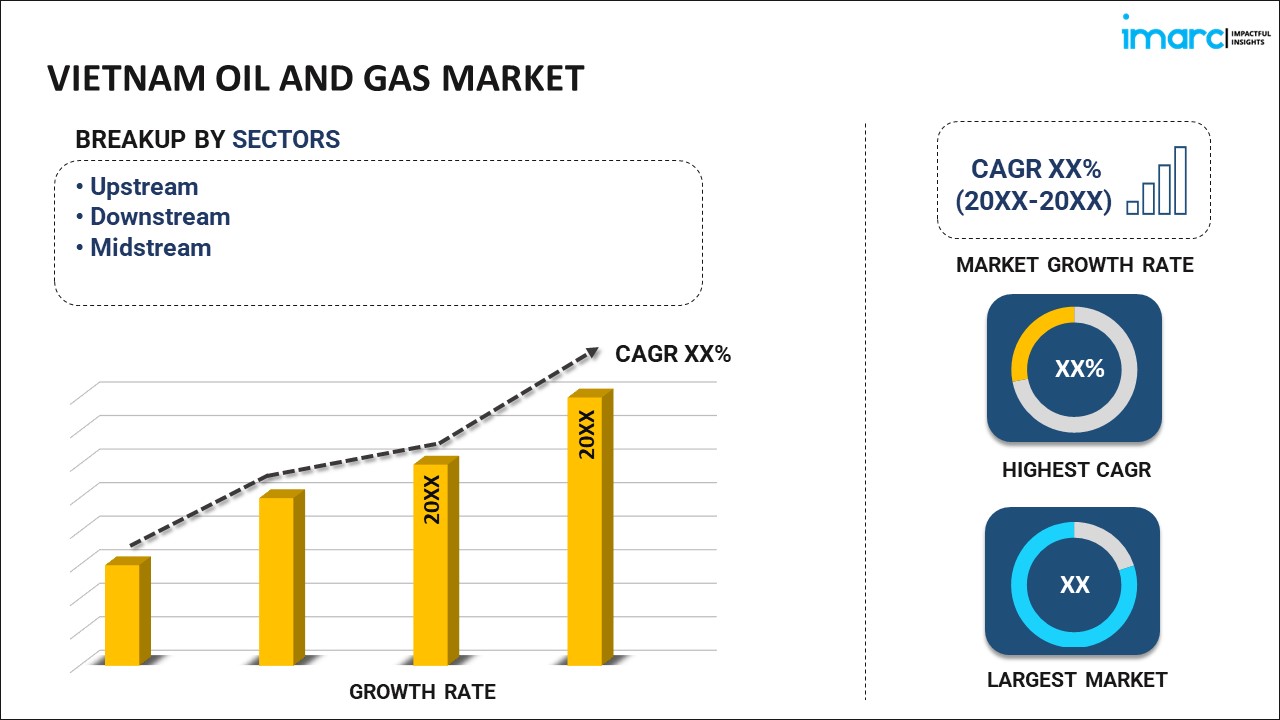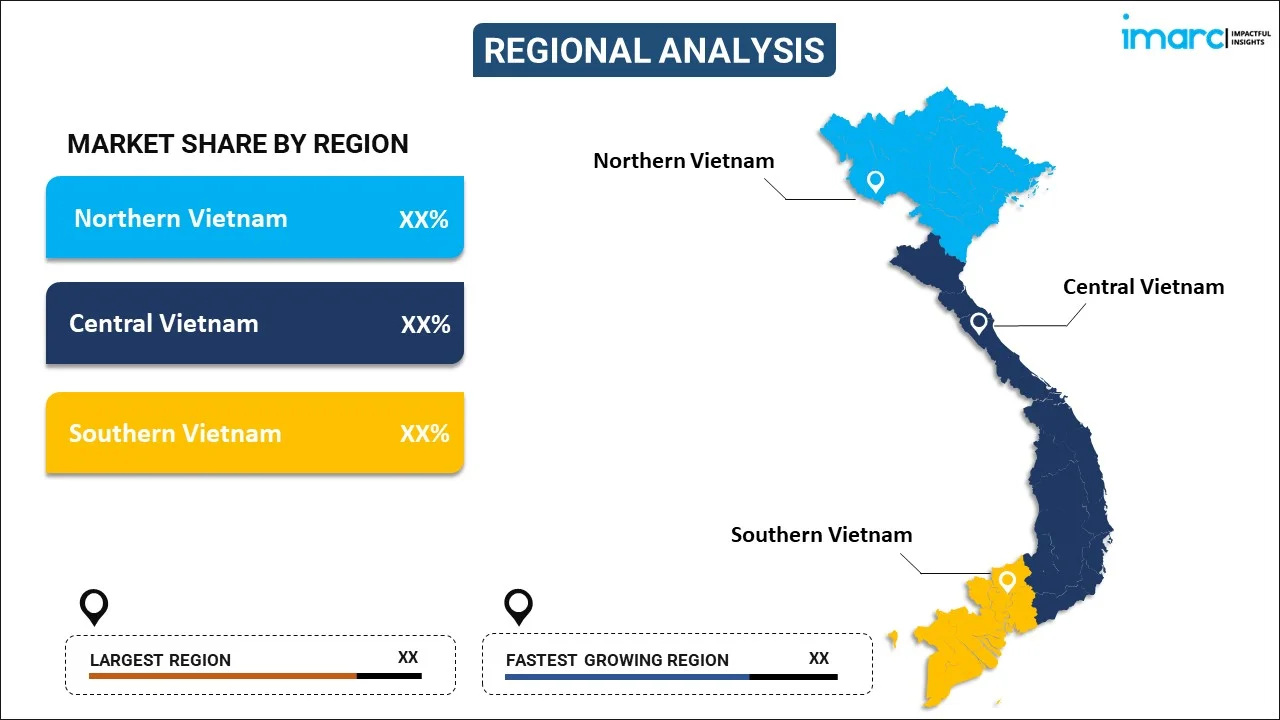
Vietnam Oil and Gas Market Report by Sector (Upstream, Downstream, Midstream), and Region 2025-2033
Market Overview:
Vietnam oil and gas market size reached USD 80.0 Million in 2024. Looking forward, IMARC Group expects the market to reach USD 110.0 Million by 2033, exhibiting a growth rate (CAGR) of 3.11% during 2025-2033. The increasing demand for energy, rapid industrialization, rising economic growth, and the growing demand for oil and gas as essential fuels for industries, transportation, and infrastructure development are some of the key factors driving the market.
|
Report Attribute
|
Key Statistics
|
|---|---|
|
Base Year
|
2024 |
|
Forecast Years
|
2025-2033
|
|
Historical Years
|
2019-2024
|
| Market Size in 2024 | USD 80.0 Million |
| Market Forecast in 2033 | USD 110.0 Million |
| Market Growth Rate (2025-2033) | 3.11% |
Oil and gas, a pivotal sector in the global energy landscape, are critical resources that power economies, industries, and everyday life. Extracted from reservoirs beneath the Earth's surface, crude oil undergoes a complex refinement process to yield various products, including gasoline, diesel, jet fuel, and petrochemicals. As primary energy sources, oil and gas are indispensable in meeting the world's energy demand, fueling transportation, electricity generation, and heating. Additionally, petrochemicals derived from these resources serve as building blocks for many products, from plastics and pharmaceuticals to fertilizers and synthetic materials. The oil and gas industry is marked by a complex global supply chain, with major producers often concentrated in specific regions, leading to geopolitical dynamics and economic dependencies. Technological advancements, such as hydraulic fracturing and deep-sea drilling, have expanded the industry's reach, unlocking previously inaccessible reserves. As a cornerstone of the global economy, the oil and gas industry's influence extends beyond energy provision. Its economic significance is underscored by employment generation, infrastructural development, and revenue generation for oil-producing nations. Historically, The sector has provided stability and revenue for oil-producing nations, enabling infrastructure, education, and healthcare investments. Moreover, ongoing efforts to explore and implement sustainable practices demonstrate the industry's commitment to environmental responsibility. Collaborative initiatives for research and development in clean energy technologies underscore a positive trajectory toward a more balanced and environmentally friendly future for the oil and gas sector.
Vietnam Oil and Gas Market Trends:
The market growth in Vietnam is primarily driven by the increasing economic development. As the country's economy expands, there is a parallel rise in energy consumption for industrial activities, transportation, and infrastructure development, boosting the demand for oil and gas. Furthermore, the growing population and urbanization contribute to an escalating demand for energy. Oil and gas remain crucial in meeting this demand, providing the primary energy sources for the country's expanding industries and transportation sector. Apart from this, the heavy investments in upstream activities, including exploration and drilling, are enhancing the country's capacity to discover and exploit new oil and gas reserves. This supports the current market and positions the country as a key player in the regional energy landscape. Moreover, the ongoing infrastructure development initiatives, such as the construction of pipelines and refineries, are enhancing the efficiency of the oil and gas supply chain. This infrastructure development is vital for the seamless transportation, refining, and distribution of oil and gas products. Besides, the government's support and strategic initiatives in the oil and gas sector contribute significantly to market growth. Policies that encourage exploration, production, and foreign investments play a pivotal role in fostering a conducive environment for industry development. Compared to other regions, relative political stability in Vietnam ensures a conducive environment for oil and gas operations. This stability attracts international investors and contributes to the country's ability to attract foreign capital for oil and gas projects. Additionally, the escalating adoption of advanced technologies in exploration, extraction, and downstream operations enhances the efficiency and productivity of the oil and gas sector, supporting its growth in a competitive global market.
Vietnam Oil and Gas Market Segmentation:
IMARC Group provides an analysis of the key trends in each segment of the market, along with forecasts at the country level for 2025-2033. Our report has categorized the market based on sector.
Sector Insights:

- Upstream
- Downstream
- Midstream
The report has provided a detailed breakup and analysis of the market based on the sector. This includes upstream, downstream, and midstream.
Regional Insights:

- Northern Vietnam
- Central Vietnam
- Southern Vietnam
The report has also provided a comprehensive analysis of all the major regional markets, which include Northern Vietnam, Central Vietnam, and Southern Vietnam.
Competitive Landscape:
The market research report has also provided a comprehensive analysis of the competitive landscape in the market. Competitive analysis such as market structure, key player positioning, top winning strategies, competitive dashboard, and company evaluation quadrant has been covered in the report. Also, detailed profiles of all major companies have been provided.
Vietnam Oil and Gas Market Report Coverage:
| Report Features | Details |
|---|---|
| Base Year of the Analysis | 2024 |
| Historical Period | 2019-2024 |
| Forecast Period | 2025-2033 |
| Units | Million USD |
| Scope of the Report | Exploration of Historical and Forecast Trends, Industry Catalysts and Challenges, Segment-Wise Historical and Predictive Market Assessment:
|
| Sectors Covered | Upstream, Downstream, Midstream |
| Regions Covered | Northern Vietnam, Central Vietnam, Southern Vietnam |
| Customization Scope | 10% Free Customization |
| Post-Sale Analyst Support | 10-12 Weeks |
| Delivery Format | PDF and Excel through Email (We can also provide the editable version of the report in PPT/Word format on special request) |
Key Questions Answered in This Report:
- How has the Vietnam oil and gas market performed so far and how will it perform in the coming years?
- What has been the impact of COVID-19 on the Vietnam oil and gas market?
- What is the breakup of the Vietnam oil and gas market on the basis of sector?
- What are the various stages in the value chain of the Vietnam oil and gas market?
- What are the key driving factors and challenges in the Vietnam oil and gas?
- What is the structure of the Vietnam oil and gas market and who are the key players?
- What is the degree of competition in the Vietnam oil and gas market?
Key Benefits for Stakeholders:
- IMARC’s industry report offers a comprehensive quantitative analysis of various market segments, historical and current market trends, market forecasts, and dynamics of the Vietnam oil and gas market from 2019-2033.
- The research report provides the latest information on the market drivers, challenges, and opportunities in the Vietnam oil and gas market.
- Porter's five forces analysis assist stakeholders in assessing the impact of new entrants, competitive rivalry, supplier power, buyer power, and the threat of substitution. It helps stakeholders to analyze the level of competition within the Vietnam oil and gas industry and its attractiveness.
- Competitive landscape allows stakeholders to understand their competitive environment and provides an insight into the current positions of key players in the market.
Need more help?
- Speak to our experienced analysts for insights on the current market scenarios.
- Include additional segments and countries to customize the report as per your requirement.
- Gain an unparalleled competitive advantage in your domain by understanding how to utilize the report and positively impacting your operations and revenue.
- For further assistance, please connect with our analysts.
 Inquire Before Buying
Inquire Before Buying
 Speak to an Analyst
Speak to an Analyst
 Request Brochure
Request Brochure
 Request Customization
Request Customization




.webp)




.webp)












